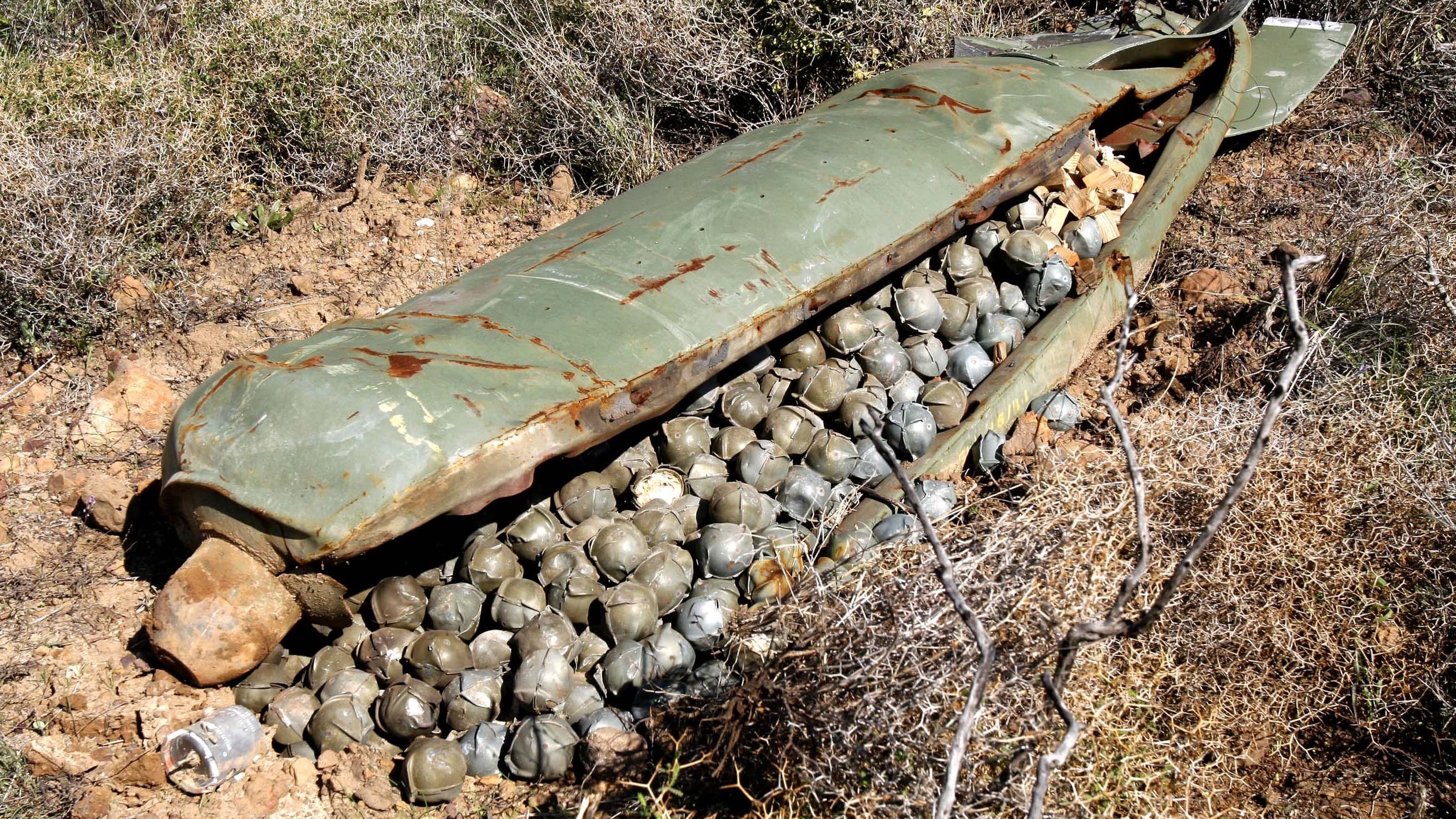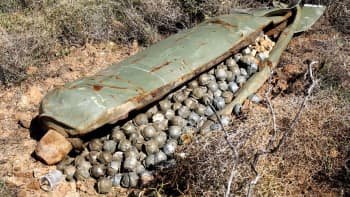CLUSTER MUNITIONS

What is the problem?
Cluster munitions, sometimes referred to as cluster bombs, are weapons which are dropped from aircraft or fired from the ground and which contain and disperse tens or hundreds of small explosive submunitions. They pose a threat to civilians both during and after use.
Cluster munitions are wide-area-effect weapons that spread their submunitions over areas that can be as large as several football fields in size, killing and injuring civilians and combatants indiscriminately. Often, large numbers of submunitions fail to function as designed, and remain on the ground and other surfaces unexploded, posing a threat to anyone in the area for decades after a conflict ends.
Cluster bombs have killed and injured thousands of civilians throughout the history of their use, and continue to account for new casualties today.
What is the current situation?
The Convention on Cluster Munitions (CCM) was adopted in 2008 and entered into force in 2010. The CCM prohibits the use, production, transfer, and stockpiling of cluster munitions. It also requires that each State Party clear cluster munition remnants in areas under its jurisdiction or control as soon as possible and within ten years (Article 4), and destroy stockpiles as soon as possible and within eight years (Article 3). Assistance to fulfil the rights of victims of cluster munitions is also required by the treaty (Article 5).
Over 60% of the world’s states have formally committed to the goals of the CCM through their signature, ratification, or accession. This includes 111 States Parties that are legally bound by all the Convention’s provisions, in addition to 12 signatories that have signed the Convention, but have yet to ratify. The CCM has rapidly gained momentum and has had a normative effect against the use of cluster munitions. Since the adoption of the CCM in 2008, there have been no reports of new use of cluster munitions by any State Party.
Unfortunately, cluster munitions continue to be used by a small handful of states not party to the Convention.
Recent use includes in Ukraine and Syria, with severe and harmful effects to the civilian population.
The States Parties to the CCM are showing an impressive commitment to rapidly implement the Convention’s Article 3 obligation to destroy their stockpiles of cluster munitions.
There are still many states and other areas with confirmed or suspected CMR-contaminated areas under their jurisdiction or control. The good news is that with political will, sustained funding, and application of efficient land release techniques, it is possible for all but the most heavily contaminated countries to complete cluster munition clearance within a few years.
What is NPA’s call?
NPA calls on all states and stakeholders to ensure full implementation of the CCM. In particular, NPA calls on States Parties to fulfil their Article 4 clearance obligations and Article 3 stockpile destruction obligations as soon as possible. Strong political will is the key to reaching this objective.
Concretely, NPA calls for the following:
- All states should: ratify/accede to the CCM if not already a State Party.
- All states and non-state armed groups should: renounce the use of cluster munitions and destroy all stockpiled cluster munitions.
- Cluster munition remnant-contaminated states should:
Conduct a nationwide survey, if needed, to establish a baseline of contamination, including the location and extent of cluster munition-contaminated areas.
Establish an ambitious national strategy and work plan for completion of their clearance obligations under Article 4 of the CCM.
Build the necessary mine action institutions and capacities, and establish policies, laws, and national mine action standards that enable the application of best practice in all aspects of their national mine action programme, including land release methodology;
Ensure the application of best practice in land release i.e. high-quality, evidence-based survey to determine the location and size of cluster munition remnant contaminated areas, and to help ensure that full clearance only takes place in areas that are confirmed as contaminated. This has significant potential for improved efficiency and swifter Article 4 treaty compliance.
Identify national resources that could be allocated to survey and clearance of cluster munition remnants and, if needed, mobilise international assistance and cooperation.
Maintain a high-quality information management system to systematically collect, store, and analyse data on cluster munition remnant contamination, and on non-technical survey (NTS), technical survey (TS), and clearance efforts disaggregated from mine clearance and with submunitions disaggregated from other forms of unexploded ordnance.
Plan for residual risk and a sustainable national capacity required to address it. - States Parties with stockpiles should: establish an ambitious plan for completion of their stockpile destruction obligations under Article 3 of the Convention, including securing resources, establishing the necessary institutions, and building capacities for timely implementation.
- Donor states should: provide sustained, or for some countries, increased levels of funding for survey and clearance of cluster munition remnants, while making clear calls on recipient governments and partners in affected countries to apply best practice in survey and clearance methodologies.
Make assistance for cluster munition stockpile destruction as systematic as other types of mine action assistance, and develop programmes for the provision of such aid to countries that require assistance for stockpile destruction.
NPA supports National Mine Action Authorities (NMAAs) to establish effective resource mobilisation strategies, including funding from the national budget, and encourages effective donor coordination through our capacity development of NMAAs.
We also promote the establishment of country coalitions to ensure regular dialogue among all stakeholders, including donors.
We encourage all mine action stakeholders to consider assessments of and recommendations for each national mine action programme, based on indicators that reflect international good practice, as found in Mine Action Review’s Clearing Cluster Munition Remnants annual report.
What does NPA do?
NPA’s advocacy in support of the above calls is an integral component of all our mine action programmes worldwide.
On a global level, NPA actively participates in relevant forums that aim to enhance the quality and coordination of mine action, such as the annual Meetings of States Parties to the CCM (and the five-yearly review conferences), the annual International Meeting of National Mine Action Programme Directors and United Nations Advisers, and other international, regional, and national CCM or mine action-related meetings.
NPA supports national authorities to understand and implement the requirements of conventions and international standards by strengthening national capacity to adopt stronger and more effective national policies, strategies and norms.
NPA’s advocacy on the issue of cluster munitions is carried out in partnership with like-minded disarmament and mine action NGOs and as a member of the Cluster Munition Coalition (CMC).
In addition, NPA publishes the Mine Action Review’s annual Clearing Cluster Munition Remnants report and serves on the Advisory Board of Mine Action Review.

